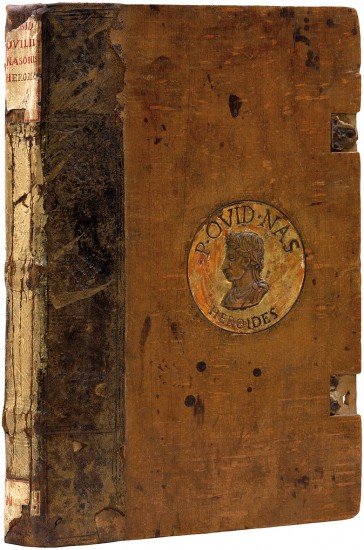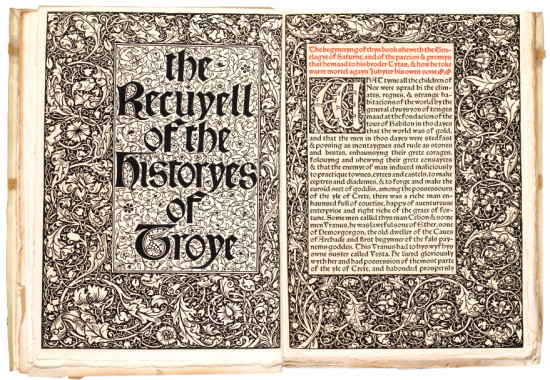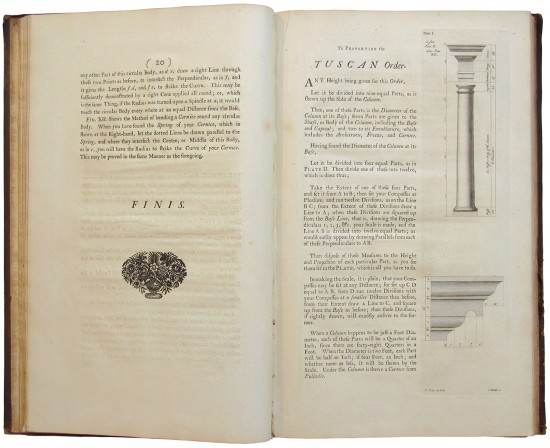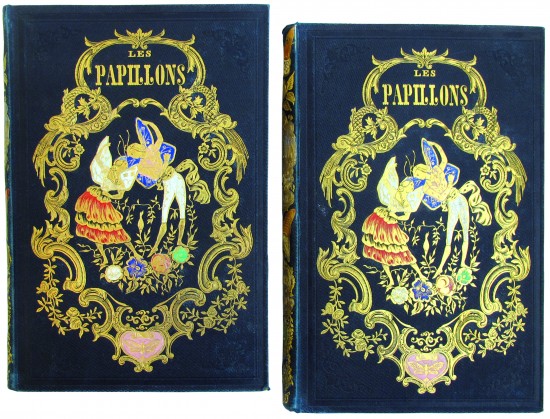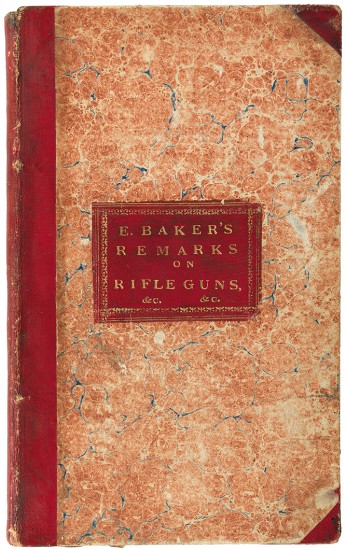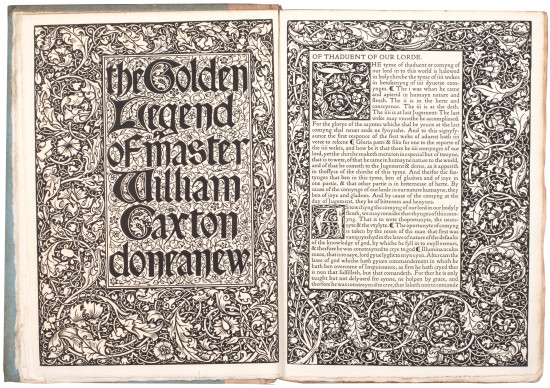P. Ovidii Nasonis Heroides ... In Ibin ... &c
Ovid (Publius Ovidius Naso)
Venice. Ionnis Tacuini da Tridino. 1525
A beautiful, untrimmed and large-margined copy of this scarce illustrated edition of Ovid's Heroides in an intriguing contemporary binding.
The Roman poet Ovid (43 B.C. - 17 A.D.), friend to Horace, Propertius and Hyginus, antagonist of Augustus, and contemporary of Virgil, was one of the most famous and important poets of his day. Noted for the elegance of his verse and his supreme creative powers, with his 'Amores', 'Heroides', 'Medicamina Faciei', 'Ars Amatoria', 'Metamorphoses', and 'Tristia', Ovid wrote some of the most influential poetry of any age, influencing - among many others - Chaucer, Dante and Shakespeare.
The present work, Ovid's 'Heroides', is a collection of literary epistles in elegaic couplets, written in the person of the most important and famous aggrieved heroines of classical mythology. Of extreme originality - Ovid claimed in the 'Ars Amatoria' to have created a new literary genre - the fact of writing in the persona of another is undoubtedly novel in a literary context and critics have argued that in the Heroides Ovid prefigured the modern novel. Fifteen of the twenty-two letters are written solely from the point of view of the heroine, but also included (and subject to debate as to authorship) are the six 'double Heroides', letters written from, for example, Leander to Hero, but also Hero to Leander.
The letters included - in the order in which they are printed - are: Penelope to Ulysses, Phyllis to Demoophon, Briseis to Achilles, Phaedra to Hippolytus, Oenone to Paris, Hypsipyle to Jason, Dido to Aeneas, Hermione to Orestes, Deianira to Hercules, Ariadne to Theseus, Canace to Macareus, Medea to Jason, Laodamia to Protesilaus, Hypermnestra to Lynceus, Paris to Helen and Helen to Paris, Leander to Hero and Hero to Leander, Acontius to Cydippe and Cydippe to Acontius, and Sappho to Phaon; it is worth noting that both Jason and Paris appear twice.
' ... Ovid's treatment of his literary sources is particularly ingenious; the correspondence of Paris and Helen is one of antiquity's minor masterpieces.' (Encyclopedia Britannica).
Giovanni Tacuino produced a number of illustrated editions of the Heroides, the first issued in 1501, all using the same series of 22 influential woodcuts 'de la main du graveur qui a travaillé pour le Legendario delli Sancti, 30.xii.1504 et pour le De Fastis, 4.vi.1508' (Essling). The woodcuts that open each epistle are composed as a triptych, with each block divided into three bordered compartments, and show several details from each of the poetic episodes. The woodcuts were so successful that rival printers adapted them for their own editions of the same work and Tacuino issued further editions of the same work, with differences in preliminary matter and commentary, in 1505, 1510, 1512, 1516, 1522 and 1525, as here (see Essling pp. 900 - 903).
The two final woodcuts, larger and composed as single tableaux, illustrating the letter from Sappho to Phaon and the final work, Ovid's 'curse poem' of rhetorical invective against an individual given only the pseudonym 'Ibis', prompted Essling to write: 'Deux surtout sont remarquables, SAPPHO ... dont la composition est assez bonne, et surtout INVIDIA ... qui est d'une belle allure, d'un beau dessin et qui nous rappelle les grands maîtres de style mantegnesque'.
The contemporary binding presents an interesting feature: the circular relief portrait medallion of a laurelled Ovid in profile. Carved directly into the front board and heightened with gilt, the vignette is highly unusual and from its form appears to be based on a medallion or engraved gem. A surviving Roman-era medallion portrait of Ovid is known but the vignette here was likely added at a later date. We can trace no similar examples of such a binding, although the British Library holds a Byzantine manuscript in canvas-backed wooden boards with carved illustration to the front board; an intriguing binding such as this would certainly have appealed to the collector Hauck and it comes as little surprise that he owned it.
All of Tacuino's illustrated editions of the Heroides are scarce, both in institutions and on the market, but for the present edition we trace only the copy of the British Library in the UK, together with two copies in Germany (at the Badisches Landesbibliothek and at Sachsen-Anhalt) and a single copy in the U.S., that at Yale.
'Illustrations for the Epistolae [Heroides] in Italy and France generally followed Giovanni Tacuino's Venice edition of 1501, where the blocks were divided into three compartments showing successive scenes and usually the writing and receipt of the letter.' (Mortimer).
[Sander 5286 (see also 5265 etc.); Essling 1150; BMC STC Italian pg. 480].
The Roman poet Ovid (43 B.C. - 17 A.D.), friend to Horace, Propertius and Hyginus, antagonist of Augustus, and contemporary of Virgil, was one of the most famous and important poets of his day. Noted for the elegance of his verse and his supreme creative powers, with his 'Amores', 'Heroides', 'Medicamina Faciei', 'Ars Amatoria', 'Metamorphoses', and 'Tristia', Ovid wrote some of the most influential poetry of any age, influencing - among many others - Chaucer, Dante and Shakespeare.
The present work, Ovid's 'Heroides', is a collection of literary epistles in elegaic couplets, written in the person of the most important and famous aggrieved heroines of classical mythology. Of extreme originality - Ovid claimed in the 'Ars Amatoria' to have created a new literary genre - the fact of writing in the persona of another is undoubtedly novel in a literary context and critics have argued that in the Heroides Ovid prefigured the modern novel. Fifteen of the twenty-two letters are written solely from the point of view of the heroine, but also included (and subject to debate as to authorship) are the six 'double Heroides', letters written from, for example, Leander to Hero, but also Hero to Leander.
The letters included - in the order in which they are printed - are: Penelope to Ulysses, Phyllis to Demoophon, Briseis to Achilles, Phaedra to Hippolytus, Oenone to Paris, Hypsipyle to Jason, Dido to Aeneas, Hermione to Orestes, Deianira to Hercules, Ariadne to Theseus, Canace to Macareus, Medea to Jason, Laodamia to Protesilaus, Hypermnestra to Lynceus, Paris to Helen and Helen to Paris, Leander to Hero and Hero to Leander, Acontius to Cydippe and Cydippe to Acontius, and Sappho to Phaon; it is worth noting that both Jason and Paris appear twice.
' ... Ovid's treatment of his literary sources is particularly ingenious; the correspondence of Paris and Helen is one of antiquity's minor masterpieces.' (Encyclopedia Britannica).
Giovanni Tacuino produced a number of illustrated editions of the Heroides, the first issued in 1501, all using the same series of 22 influential woodcuts 'de la main du graveur qui a travaillé pour le Legendario delli Sancti, 30.xii.1504 et pour le De Fastis, 4.vi.1508' (Essling). The woodcuts that open each epistle are composed as a triptych, with each block divided into three bordered compartments, and show several details from each of the poetic episodes. The woodcuts were so successful that rival printers adapted them for their own editions of the same work and Tacuino issued further editions of the same work, with differences in preliminary matter and commentary, in 1505, 1510, 1512, 1516, 1522 and 1525, as here (see Essling pp. 900 - 903).
The two final woodcuts, larger and composed as single tableaux, illustrating the letter from Sappho to Phaon and the final work, Ovid's 'curse poem' of rhetorical invective against an individual given only the pseudonym 'Ibis', prompted Essling to write: 'Deux surtout sont remarquables, SAPPHO ... dont la composition est assez bonne, et surtout INVIDIA ... qui est d'une belle allure, d'un beau dessin et qui nous rappelle les grands maîtres de style mantegnesque'.
The contemporary binding presents an interesting feature: the circular relief portrait medallion of a laurelled Ovid in profile. Carved directly into the front board and heightened with gilt, the vignette is highly unusual and from its form appears to be based on a medallion or engraved gem. A surviving Roman-era medallion portrait of Ovid is known but the vignette here was likely added at a later date. We can trace no similar examples of such a binding, although the British Library holds a Byzantine manuscript in canvas-backed wooden boards with carved illustration to the front board; an intriguing binding such as this would certainly have appealed to the collector Hauck and it comes as little surprise that he owned it.
All of Tacuino's illustrated editions of the Heroides are scarce, both in institutions and on the market, but for the present edition we trace only the copy of the British Library in the UK, together with two copies in Germany (at the Badisches Landesbibliothek and at Sachsen-Anhalt) and a single copy in the U.S., that at Yale.
'Illustrations for the Epistolae [Heroides] in Italy and France generally followed Giovanni Tacuino's Venice edition of 1501, where the blocks were divided into three compartments showing successive scenes and usually the writing and receipt of the letter.' (Mortimer).
[Sander 5286 (see also 5265 etc.); Essling 1150; BMC STC Italian pg. 480].
[138 leaves: 24 unnumbered leaves, 113 leaves with foliation in Roman numerals I - CXIII at upper right, terminal blank leaf]. Collation: AA6 - DD6, A6 - I6, K6 - T6. Folio. (314 x 204 mm). Printed title in red and black with elaborate woodcut border, verso with 'Lectoribus', 23 leaves with laudatory texts, commentaries, introductions and index and Ovid's Heroides illustrated with 22 woodcuts, one for each verse epistle: 20 as triptychs (each c.80 x 130 mm) illustrating each letter and two larger woodcuts (each c.105 x 160 mm) for Sappho to Phaon and 'In Ibin' together with woodcut diagram, final leaf with peroration and life of Ovid by Antonium Volscum recto, life of Ovid by Christophorum Zarotum, register and colophon verso, final blank leaf. Printed text in Latin in Roman type throughout with occasional insertions in Greek, Ovid's text with extensive surrounding commentary and printed marginal notes. Ovid's text with nine-line introductory initials to each letter throughout, commentary with four-line decorative and historiated intitals throughout. Occasional minor soiling and staining, occasional annotation in sepia with pen trials to inital and terminal blanks, several woodcuts with partial colouring. Sheet size: 312 x 212 mm). Contemporary goatskin-backed bevelled wooden boards, front board with central circular relief vignette portrait of Ovid (see below) with text 'P . OVID . NAS / HEORIDES' and heightening in gilt, spine with decorative tooling and rules in blind, later paper label with manuscript title in red and remains of location label (?) at foot, remains of two leather clasps at fore edge, later wool-lined green cloth box with gilt title to spine and red leather label with gilt ex-libris to front cover.
#45026
